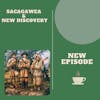Sacagawea & New Discovery

This week I dive into the Lewis and Clark expedition and the only woman to join the Corps of Discovery, Sacagawea.
Much of Sacagawea's life remains a mystery, but one thing that is certain is her impact and influence over the 5,000 mile journey undertaken by Meriwether Lewis and William Clark and the Corps of Discovery.
In this episode I cover the history of the Louisiana Purchase, the origins of Sacagawea and provide an overview of the journey to survey the new land.
Sources Used This Episode:
Austin, Alan, director. The Journey of Sacagawea, PBS, 2004, (LINK)
Biography.com Editors, “Sacagawea Biography.” Biography.com. Accessed 7/16/2021.
https://www.biography.com/explorer/sacagawea
Harriss, Joseph. How the Louisiana Purchase Changed the World. Smithsonian Magazine. April 2003. (LINK)
"Indigenous Tribes of New Orleans & Louisiana", American Library Association, April 13, 2018. (Accessed July 22, 2021). Document ID: d7e52bf6-0acc-4316-9729-153b015059c7 (LINK)
“The Journey West.” Monticello, Accessed 7/17/2021. (LINK)
“The Louisiana Purchase.” Monticello, Accessed 7/16/2021. (LINK)
Potter, Teresa, and Mariana Brandman. "Sacagawea." National Women's History Museum. National Women's History Museum, 2021. Accessed 7/20/2021. (LINK)
Schultz, James Willard. Bird Woman: Sacagawea's Own Story. Mountain Meadow Press, 1999.
U.S. Department of State. (n.d.). Louisiana Purchase, 1803. U.S. Department of State. https://history.state.gov/milestones/1801-1829/louisiana-purchase
Support the show (http://www.buymeacoffee.com/civicscoffeepod)
Welcome to Civics and Coffee. My name is Alycia and I am a self-professed history nerd. Each week, I am going to chat about a topic on U.S history and give you both the highlights and occasionally break down some of the complexities in history; and share stories you may not remember learning in high school. All in the time it takes to enjoy a cup of coffee.
INTRO MUSIC
Hey Peeps! Welcome back.
This week I wanted to dive into the story of someone in history who is surrounded by mystery. I was hoping I would be able to flesh out her story a bit more and lift the cloud. Unfortunately, there isn’t much out there for her so I had to deviate a little and combine her story with the story of a more well known tale.
Today I am diving into Sacagawea and the survey of the new land purchased under Thomas Jefferson’s administration. Who was Sacagawea? How much of her story is true?
Grab your cup of coffee peeps, lets do this.
Before we get into the story of Sacagawea, let’s lay the groundwork for what caused her to become infamous.
Thomas Jefferson, third president of the United States, was facing a bit of a crisis. Americans who since 1795 had enjoyed the use of the Mississippi River for transport of their goods and the port city of New Orleans to store their wares duty free were suddenly facing new terms. In October 1802, Spanish King Charles IV signed a royal decree officially transferring the territory to the French government.
And that made Jefferson - and the United States - very nervous. French leader Napoleon Bonaparte had a vision of expanding the french empire in the region, starting with recapturing the profitable sugar colony on the island of St. Domingue and using New Orleans - and the Mississippi - as the place to store the goods.
If you remember from my episode about Adams’ presidency, tensions between the United States and France were a little fraught. While they had peacefully resolved the quasi war a couple of years prior, there was still concern about the French and what exactly their leader was capable of. Napoleon wasn’t exactly known for being a moderate and there was fear of French attacks in the south and that their military would free enslaved individuals, leading to massive slave uprisings throughout the plantations in the Louisiana territories.
Adding to the tensions was the threat of violent seizure of New Orleans by frontiersmen who were angered about the loss of their access to the port. This angry mob seemed to be gaining momentum, with support building for a demand to call for an army to seize the city by force if necessary.
Adding to the turmoil were the Federalists; out of power and adamantly opposed to Jefferson and his presidency, they smelled blood and started calling for hostile actions against France. Jefferson knew he had to take action to quell both his political adversaries and to appease the plantation owners and traders along the western border of the United States. So while he made military preparations along the Mississippi Valley, he also engaged in a diplomatic effort to try to convince France to sell their claim to Louisiana.
Robert Livingston, serving as minister to France had been tasked with trying to negotiate the sale of New Orleans with french diplomat Carles Maurice de Talleyrand. Inexperienced and unable to get through the French version of diplomacy, Livingston was frustrated and not gaining a lot of traction. Jefferson, committed to his vision of obtaining the territory, threw all his cards on the table and asked friend and Secretary of State James Monroe to sail to France and aid Livingston in the negotiations. The quote “future destinies of this republic” end quote depended solely on Monroe and Livingston’s ability to secure a deal. No pressure.
And if you live in the United States, or have ever looked at a map of the country, then you know they succeeded. But how did it all go down? Napoleon, whose forces were being decimated by yellow fever in Saint Domingue, started having second thoughts regarding the usefulness of holding onto New Orleans and, eyeing another fight with the British, knew any conflict with their navy would require cash. Reaching an agreement on April 30, 1803 the United States acquired the landmass known as the Louisiana Territory for 15 million dollars. Covering over 800,000 acres, the treaty was considered a steal, as the United States paid roughly four cents an acre.
Jefferson was initially hesitant in signing the treaty, worried that such an agreement was not permitted by the United States Constitution. He originally considered proposing an amendment to grant him the powers, but changed his mind and with a few strokes of a pen, cemented himself in history as the president who nearly doubled the republic. Of course, this land transaction was done without the involvement or consent of the original inhabitants of the area. Several native tribes such as the Chitimacha, the Coushatta and the Jena Band of Choctaw were left out of the discussion and financial agreements about dividing up their homeland.
Despite this, the United States had new territory and now needed someone to map it out and figure out what natural resources were available and document exactly what they purchased for fifteen million. Jefferson decided to ask his personal secretary, Meriwether Lewis, a man with no prior surveying experience, to make preparations to scour the new land. Lewis, partnered with former military commander William Clark to assist in the expedition.
Known in history as the Corps of Discovery, the group consisted of several men chosen mainly for their ability to survive on the frontier. They made their preparation and headed west, spending the winter of 1803 at Camp Dubois along the eastern bank of the Mississippi River. They officially departed camp on May 14, 1804 and started their survey of the newly acquired territory. Capturing their observations in journals and mapping the new territory, the expedition sent packages back to the White House to keep Jefferson apprised of their progress.
Arriving in North Dakota in October, 1804 the Corps of Discovery came into contact with members of the Mandan and Hidatsa tribes. And here is where I will diverge from our story a little to share the origins of the famed tracker who was the only woman to join the Lewis and Clark team, Sacagawea.
A lot about Sacagawea unfortunately remains unknown. This is due partially to the fact that she was a woman and partially due to the fact that she was indigenous and therefore did not capture her daily life with journals. Native history is done through oral tradition and so we’re left with very little primary evidence of her life outside of the journals written by members of the Corps of Discovery. But through the oral history, we feel fairly confident on a few points.
Sacagawea was believed to be born in 1788 in Salmon, Idaho. She is known by many names and each has it’s own history and meaning. The most common moniker is Sacagawea, which is the Hidatsa dialect and translated to bird woman. At the turn of the twentieth century, historian James Willard Schultz wrote an oral biography of sorts about Sacagawea, titled Bird Woman: the Guide of Lewis & Clark. However other oral histories refer to her by her shoshone name of Sacajawea which means boat launcher. Since she is most commonly referred to as Sacagawea, that is the name I will use throughout the episode.
She was born into the Lemhi Shoshone tribe, a nomadic band of the Northern Shoshone who ate a diet of primarily fish and berries farmed from their surrounding areas, occasionally venturing out to hunt for larger game like buffalo. As a young girl, she was taught to be mindful of her surroundings and memorize her terrain.
At the age of twelve she was stolen by the rival Hidatsa tribe and taken to their village near what is today known as Bismark, North Dakota. The taking of children was a fairly common practice between the tribes and upon her arrival, she was placed with a family who had recently lost a daughter of a similar age and spent a few years learning the Hidatsa way of life.
Around the age of 15 or 16 she came into contact with french canadian trader Toussaint Charbonneau, a man nearing 40. Accounts differ as to just what went down, but Sacagawea was either sold to Charbonneau or given to him as the result of a bet from a game play between Charbonneau and the man responsible for Sacagawea within the tribe. Either way, at the age of 15, she was forced into a marriage with the older man, who was already married.
When Lewis and Clark arrived in the Hidatsa tribal area, they came into contact with Charbonneau and he was hired to guide the team west. Importantly, Sacagawea was also selected to join the group, though she received no monetary payment for her time. The Corps of Discovery had a translator on hand, however as they moved further west, they knew they would encounter indigenous people who their translator may prove useless. Sacagawea knew the Hidatsa, Shoshone and French languages and proved to be a valuable asset to the team.
And Lewis & Clark were aware of her importance to the mission, giving her the title of “interpretess” in their journals; meaning she was seen separate and apart from her spouse as an able resource to help them communicate along their journey. Sacagawea was pregnant at the time and gave birth to a son, Jean Baptiste on February 11, 1805. She would carry her son throughout the five thousand mile journey, often over rough terrain and landscapes.
After waiting through the winter and trading to get the necessary supplies, Sacagawea, Charbonneau and the Corps of Discovery left the compound built as Fort Mandan on April 7th, 1805. The 17 year old new mother joined thirty-one older men, all who served a specific purpose throughout the journey. While Sacagawea would provide translation, other men were chosen for their ability to hunt or woodwork. The group made impressive progress, covering up to twenty miles per day.
As they made their way west, the corps of discovery continued to document their observations and take samples to send back to the president, holding on to their specimens until they arrived at a viable trading post. As I mentioned before, the group had to cross through various terrain and climates, including rivers and streams.
During one of their river crossings, a boat tipped and began taking water, causing its contents to spill into the stream. Lewis and Clark looked helplessly from the shore as the boat carrying their supplies and observations, along with Charbonneau and Sacagawea, spilled everywhere. Charbonneau froze, but Sacagawea, again with a newborn infant strapped to her body, saved the proverbial day and grabbed hold of the necessary materials, leaving a very grateful Lewis and Clark.
The corps made contact with the Shoshone on August 15, 1805. Sacagawea, upon recognizing her brother, became overrun with emotions and ran to him, throwing her arms and blanket over him and visibly crying. She tried to compose herself in order to provide translations for her team, but found herself overcome and so Lewis and Clark decided to delay the meeting for another day to allow Sacagawea time to catch up with her people and find out what happened to her family.
After smoking pipe with the Shoshone leader and making trades for more supplies, the group continued westward, with Sacagawea still on board. This remains one of the mysteries of history, to me. Why, if she had the opportunity to be reunited with her tribe, would she continue on in this expedition. Whatever her reason, she continued to explore the new landscape with the researchers, reaching the pacific ocean on November 15, 1805.
Realizing the winter season was coming - and with it freezing temperatures and inclimate weather, the group decided to camp for the winter and held a discussion as to where to set up. Sacagawea, proving her usefulness and bravery, got a voice in the decision. The winter months were lean for the group and it was again Sacagawea who helped them survive, using her knowledge of plants and roots to supplement their food with vegetables and berries.
The group left their western camp on March 23, 1806 and for the first time, split into two separate groups. Sacagawea went with William Clark and guided the party south of the Yellowstone River by recommending a path through the Rocky Mountains. While she is mentioned throughout journals, I think this quote captures the main theme of her participation and reputation with the group when Clark wrote, “the indian woman has been of great service to me as a pilot through this country.” You dang right.
The survey of the new territory was seen as highly successful and the landmass covered what would eventually become fifteen new states to the union. New varieties of plants were discovered and waterways given various new monikers. While the westward expansion proved ever more deadly for the indigenous who lived there for centuries, the settlers along the frontier were jumping for joy at the prospect of all this new land.
Sacagawea’s life post the expedition remains a bit of a mystery. The prevailing theory is she died at Fort Manual in 1812 from typhoid fever shortly after giving birth to a daughter named Lisette. However some native oral histories claim Sacagawea lived until 1884.
Whatever the truth, her tangible impact on the journey exploring the western frontier cannot be denied. Without her knowledge and guidance, the group of men would have likely faced many more obstacles and challenges along their journey.
If you’ve been enjoying the podcast, please consider a rate and review on either apple podcasts or podchaser. It takes just a few moments and is a free way to show your support of the show. Also - I get to see your feedback and it always makes me giddy.
If you are looking for ways to donate to the show, please consider contributing through buy me a coffee. For the cost of a cup of jo, you can help fund the book supply and my own caffeine habit so I can continue dropping these fabulous episodes for you commercial free.
Lastly, if you want to request a topic yourself or learn more about the source material used for this episode, please check out the website at www dot civics and coffee dot com.
Thanks peeps.
Listener Favorites
Not sure where to begin? Take a listen to some fan favorites.

























